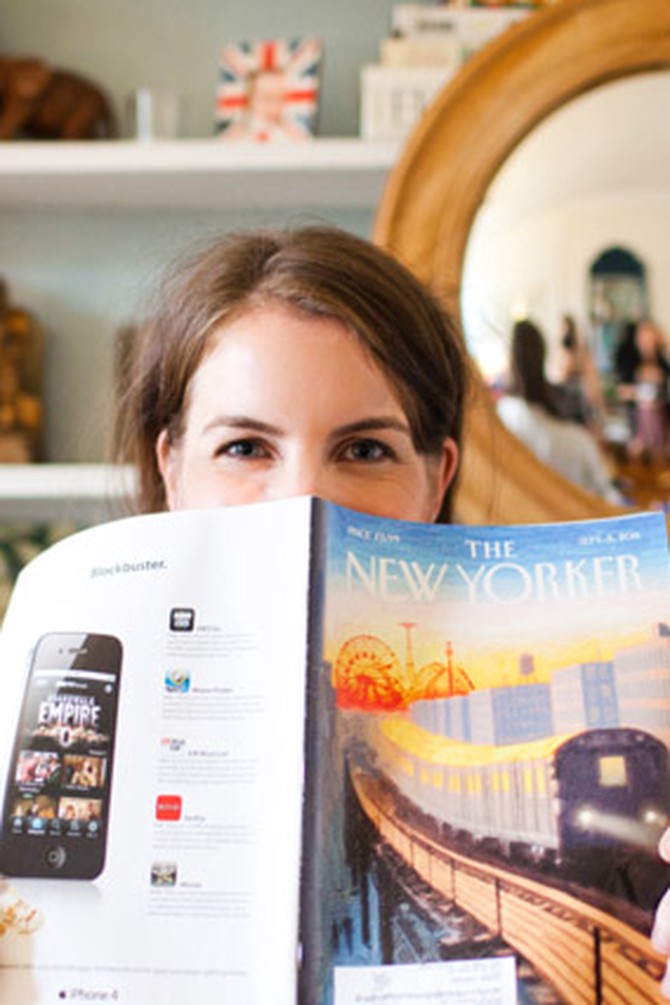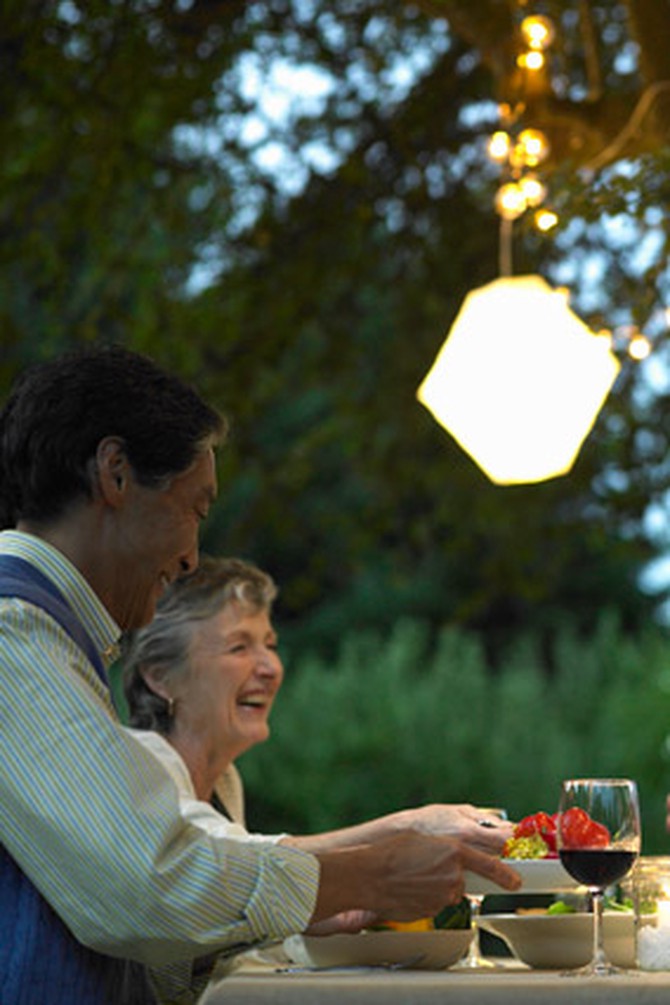5 New Book Clubs (You’ve Never, Ever Heard Of)
A few fresh book-group ideas for revamping your gatherings, starting one of your own or joining one that surprises—and delights.
By Leigh Newman

Photo: Shannen Norman
1. The Under-One-Hour-of-Reading Club
We all love our book clubs, but there comes a time when even the most ideal group (think stimulating novels, insightful members, priceless wines, organic caviar, a live harpist in the corner who strums ethereal notes after every comment) gets a little stale or a little intimidating to outsiders. Take Joanna Goddard. She always wanted to join one, but she knew she was a slow reader and that she’d never finish a 300-page novel or memoir (hmmm...unlike the rest of us who always finish). Her idea? Start a club based on something that takes only 45 minutes to read—the old-fashioned in-depth magazine article. "Articles are so digestible," she says. "And they’re real-life, which makes them easier to relate to." Another bonus is that the ideas discussed in those pieces tend to be controversial, which leads to lots of fun, even heated debate. Goddard picks her articles from magazines like The New York Times, The New Yorker and Harper’s Magazine about topics that range from education to divorce. (But this O magazine piece on hidden agendas might also do the trick)
What works: Articles about dating, marriage, siblings, family conflicts-anything that lets members weave in personal context to the factual content. One big winner in Goddard’s group was this New York Times modern-love piece about a husband who announced to his wife: "I don’t love you anymore."
What doesn’t work: Articles that have only one argument, such as "too much alcohol is bad for you." Everybody agrees it’s true, and then the discussion pretty much dies.
What works: Articles about dating, marriage, siblings, family conflicts-anything that lets members weave in personal context to the factual content. One big winner in Goddard’s group was this New York Times modern-love piece about a husband who announced to his wife: "I don’t love you anymore."
What doesn’t work: Articles that have only one argument, such as "too much alcohol is bad for you." Everybody agrees it’s true, and then the discussion pretty much dies.

Photo: Thinkstock
2. The Choose-Your-Own-Novel Club (with a Side of Pizza)
If you’re the kind of person who buys armloads of juicy new novels, then rushes home, only to shove them on the shelf where they sit there...and sit there...and sit there...either because you’re too busy buying more books or you’re still trying to finish that fat magnificent paperback edition of Middlesex you started in 2004, this club is for you. Tiffany Sun, senior web editor at Oprah.com, was drowning in books but just couldn’t find the time, energy and/or willpower to read them. She and a close friend decided to approach reading "like dieting, where you have a buddy who keeps you on track with your eating plan, because she’s doing it too," Sun says. In their club, each member reads the books she already owns. When finished with a book, she enters the title, rating, her name and any comments she wants to make about it into a Google spreadsheet that’s shared with everyone. Here comes the part that’s not—in any way, shape or form—like dieting. Once everyone has finished three books (all of each person’s choosing), the group goes out for pizza to talk about their choices and experiences, as well as to celebrate with a sausage pie. "That reward hovering in the distance is a real motivator," Sun says. "I’m not going to lie to you. Without the pizza, I don’t think any of us would make it all the way to ‘The End,’ month after month."
What works: The Google spreadsheet keeps members connected as they read separately—and gives them a feeling of accomplishment. Sun’s group also inserts a colored bar that marks the end of every reading session and also lists the name of the pizza place they visited. (They check out a different restaurant each time.)
What doesn’t work: Members who read at different speeds. "One of our friends was able to read three books a month, while the rest of us were struggling to finish even one book in the same amount of time," Sun says. "That got discouraging pretty quickly."
What works: The Google spreadsheet keeps members connected as they read separately—and gives them a feeling of accomplishment. Sun’s group also inserts a colored bar that marks the end of every reading session and also lists the name of the pizza place they visited. (They check out a different restaurant each time.)
What doesn’t work: Members who read at different speeds. "One of our friends was able to read three books a month, while the rest of us were struggling to finish even one book in the same amount of time," Sun says. "That got discouraging pretty quickly."

Photo: Thinkstock
3. The Club with a Never-Ending Supply of Books
This option is so obvious, you just might just overlook it. Many bookstores organize their own book clubs. "Now that everything everywhere happens over the Internet all the time," says Zach Zook, an coordinator for the small indie shop BookCourt in Brooklyn, "we’re seeing a real desire from customers for face-to face interactions." Sure, they come for the joy of talking about The Tiger’s Wife with strangers who in most cases have read the book (they’re not coming for the old friends and intricate hot appetizers), but they also like the honest reactions (nobody has to be very, very careful how she talks about, say, the lead character who cheats on her husband). Another perk? The flexibility. "You can come once, then not come again for four months," says Anne Cory-Watson, coordinator of BookCourt’s club. "Not to mention, we’re completely inclusive. Anybody can come. You don’t have to be insanely smart or well read. We’ll take anybody—and we have the room for them."
What works: Buying your book for the following meeting as soon as the current one ends, eliminating the errand of obtaining the next title and being relaxed about the summer when the group shrivels. ("They come back in the fall," Cory-Watson says. "Promise.")
What doesn’t work: Because of the luscious selection of new releases piled on nearby tables and shelves, you’ll be tempted to buy only recently published titles. But Cory-Watson’s group finds that many of the new books just weren’t strong enough to generate discussion. Now they read a mixture of recent and time-tested titles.
What works: Buying your book for the following meeting as soon as the current one ends, eliminating the errand of obtaining the next title and being relaxed about the summer when the group shrivels. ("They come back in the fall," Cory-Watson says. "Promise.")
What doesn’t work: Because of the luscious selection of new releases piled on nearby tables and shelves, you’ll be tempted to buy only recently published titles. But Cory-Watson’s group finds that many of the new books just weren’t strong enough to generate discussion. Now they read a mixture of recent and time-tested titles.

Photo: Thinkstock
4. The Club That Shares the Same DNA
Over the winter holidays, during summer break at the beach house or any other time when your extended family gets together, try presenting each member with the same book. As Grandma, Aunt Jane, Mom and Uncle Frank’s new (shy) girlfriend hang by the fire at night or linger around the coffeepot in the morning, they’ll read (as opposed to lecturing on their particular politics or hinting as to who should mop the kitchen floor). At night, over dinner, the group will also have something relatively safe and engaging to discuss (as opposed to talking about exactly how dry the turkey is or why Aunt Jane decided to join a coven).
What works: Rotating who chooses the book, so that everyone gets a chance. Also, keeping the book a secret until everybody arrives. (This is not one of those things you want your older brother or grumpy Uncle Boris to weigh in on ahead of time.)
What doesn’t work: Forgetting to put each person’s name in big blocky letters on the title page, leading to books to getting confused, places lost, and irritation to set in.
What works: Rotating who chooses the book, so that everyone gets a chance. Also, keeping the book a secret until everybody arrives. (This is not one of those things you want your older brother or grumpy Uncle Boris to weigh in on ahead of time.)
What doesn’t work: Forgetting to put each person’s name in big blocky letters on the title page, leading to books to getting confused, places lost, and irritation to set in.

Photo: Thinkstock
5. The Singles Club
No, we don’t mean a pick-up book club (though asking out the guy who can recite the last page of Eat Pray Love is never a bad idea...). We’re talking about one the most fascinating and of-the-moment ways to read: Kindles Singles, published only for e-readers. Officially, Amazon defines these timely pieces as anything that falls into "a vast spectrum of reporting, essays, memoirs, narratives and short stories presented to educate, entertain, excite and inform." Unofficially, we understand them as novellas, short short-story collections (such as: Jodi Picoult’s Leaving Home of three brief pieces of fiction) and longer nonfiction works that are too short to be books (think Cristina Nehring’s riveting Journey to End of Light, about her Down-syndrome baby diagnosed with leukemia.) The bonus? Each one is less than the price of a magazine.
What works: E-readers help discussion by letting members search by word or phrase—ending the whole frustrating "I know I remember the passage! It was about a rose and dog...like at the end or like at the beginning!" You can also highlight key passages and use Twitter, Facebook, Meetup, Squidoo, Library Thing and other social platforms to discuss books between meetings.
What doesn’t work: Expecting everyone body to have the same e-reader. You can still buy a Kindles Single, no matter what device. It will work just fine.
Next: 9 things never to say in a book club
What works: E-readers help discussion by letting members search by word or phrase—ending the whole frustrating "I know I remember the passage! It was about a rose and dog...like at the end or like at the beginning!" You can also highlight key passages and use Twitter, Facebook, Meetup, Squidoo, Library Thing and other social platforms to discuss books between meetings.
What doesn’t work: Expecting everyone body to have the same e-reader. You can still buy a Kindles Single, no matter what device. It will work just fine.
Next: 9 things never to say in a book club
Published 04/30/2012

